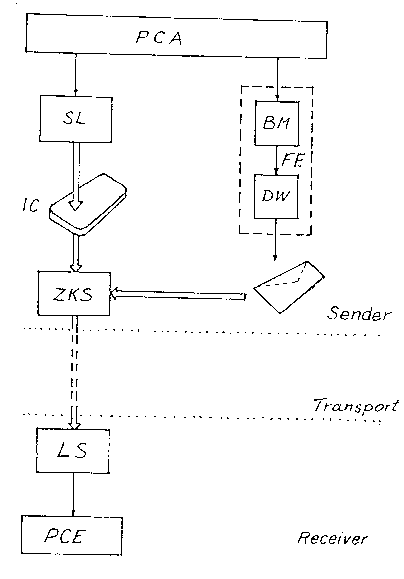Some of the information on this Web page has been provided by external sources. The Government of Canada is not responsible for the accuracy, reliability or currency of the information supplied by external sources. Users wishing to rely upon this information should consult directly with the source of the information. Content provided by external sources is not subject to official languages, privacy and accessibility requirements.
Any discrepancies in the text and image of the Claims and Abstract are due to differing posting times. Text of the Claims and Abstract are posted:
| (12) Patent: | (11) CA 2058866 |
|---|---|
| (54) English Title: | PROCESS FOR MAILING ELECTRONICALLY STORED CONTENTS OF LETTERS |
| (54) French Title: | METHODE DE MISE A LA POSTE DE LETTRES DONT LE TEXTE EST STOCKE ELECTRONIQUEMENT |
| Status: | Expired and beyond the Period of Reversal |
| (51) International Patent Classification (IPC): |
|
|---|---|
| (72) Inventors : |
|
| (73) Owners : |
|
| (71) Applicants : |
|
| (74) Agent: | SMART & BIGGAR LP |
| (74) Associate agent: | |
| (45) Issued: | 1996-12-31 |
| (22) Filed Date: | 1992-01-07 |
| (41) Open to Public Inspection: | 1992-07-18 |
| Examination requested: | 1993-12-14 |
| Availability of licence: | N/A |
| Dedicated to the Public: | N/A |
| (25) Language of filing: | English |
| Patent Cooperation Treaty (PCT): | No |
|---|
| (30) Application Priority Data: | ||||||
|---|---|---|---|---|---|---|
|
According to the procedure for mailing the contents of letters
that are stored electronically by means of flat information
carriers, for example, chip cards, the contents of the letter are
written into the information carrier by means of a read/write
module, then, synchronized with this, the mailing data such as
the address, type of mail and an advertizing field are
transferred to a franking system. The franking system computes
and charges the particular postage fees and prints a franking
impression on the item of mail that is to be used to mail the
information carrier.
Note: Claims are shown in the official language in which they were submitted.
Note: Descriptions are shown in the official language in which they were submitted.

2024-08-01:As part of the Next Generation Patents (NGP) transition, the Canadian Patents Database (CPD) now contains a more detailed Event History, which replicates the Event Log of our new back-office solution.
Please note that "Inactive:" events refers to events no longer in use in our new back-office solution.
For a clearer understanding of the status of the application/patent presented on this page, the site Disclaimer , as well as the definitions for Patent , Event History , Maintenance Fee and Payment History should be consulted.
| Description | Date |
|---|---|
| Inactive: IPC from MCD | 2006-03-11 |
| Inactive: IPC from MCD | 2006-03-11 |
| Time Limit for Reversal Expired | 2005-01-07 |
| Letter Sent | 2004-01-07 |
| Inactive: Reversal of will be deemed expired status | 2002-04-11 |
| Inactive: Office letter | 2002-04-11 |
| Letter Sent | 2002-01-07 |
| Grant by Issuance | 1996-12-31 |
| All Requirements for Examination Determined Compliant | 1993-12-14 |
| Request for Examination Requirements Determined Compliant | 1993-12-14 |
| Application Published (Open to Public Inspection) | 1992-07-18 |
There is no abandonment history.
| Fee Type | Anniversary Year | Due Date | Paid Date |
|---|---|---|---|
| MF (patent, 6th anniv.) - standard | 1998-01-07 | 1998-01-06 | |
| MF (patent, 7th anniv.) - standard | 1999-01-07 | 1999-01-04 | |
| MF (patent, 8th anniv.) - standard | 2000-01-07 | 1999-11-04 | |
| MF (patent, 9th anniv.) - standard | 2001-01-08 | 2001-01-03 | |
| MF (patent, 10th anniv.) - standard | 2002-01-07 | 2002-01-07 | |
| MF (patent, 11th anniv.) - standard | 2003-01-07 | 2002-12-03 |
Note: Records showing the ownership history in alphabetical order.
| Current Owners on Record |
|---|
| FRANCOTYP-POSTALIA GMBH |
| Past Owners on Record |
|---|
| FRIEDRICH-VIKTOR MIEHE |
| KLAUS DIETRICH |
| NORBERT KNOTH |
| STEPHAN GUNTHER |
| WOLFGANG THIEL |